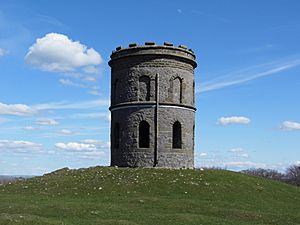Grin Low facts for kids
Quick facts for kids Grin Low |
|
|---|---|

View from the South
|
|
| Highest point | |
| Elevation | 434 metres (1,424 ft) |
| Geography | |
| Location | Buxton, Derbyshire, England |
| OS grid | SK054718 |
| Topo map | OS Explorer OL24 |
Grin Low is a hill near Buxton in Derbyshire, England. It is part of the beautiful Peak District area. The very top of the hill is 434 meters (about 1,424 feet) above sea level.
Contents
Grin Low's Industrial Past
Grin Low was once a very busy place for making lime. This started way back in 1662. People dug up lots of limestone from the ground here. They then burned it to make lime.
During the Industrial Revolution, people needed much more lime. So, the work at Grin Low grew a lot. You can still see the remains of over 100 old lime kilns. These were like big ovens made of earth and rock. They were used from the 1600s to the 1800s. There are also piles of waste rock from the digging.
Coal was brought from nearby places like Axe Edge Moor to fuel the kilns. In 1820, a Duke named William Cavendish started the 'Grin Plantation'. This is now the wooded Buxton Country Park. He wanted to hide the messy lime-making areas from visitors to Buxton.
Later, in 1831, the Cromford and High Peak Railway opened. It passed right by Grin Low. This railway made it easier to move the lime to other towns. This led to even more digging and lime production in Buxton. By the 1850s, lime production moved to a new, bigger quarry on the south side of the hill. This quarry worked until 1952. In 1890, Grin Low produced a huge 90,000 tonnes of lime! Today, this old quarry is a caravan park and campsite.
Solomon's Temple: A Tower with a View
In the 1830s, a man named Solomon Mycock rented the land at the top of Grin Low. In 1840, he built a tower called Solomon's Temple. He built it for the Duke of Devonshire. The tower was built on top of a very old burial mound. It also helped give jobs to people who needed work in the town.
By 1894, the first tower was falling apart. So, a new one was approved. This new tower, called Grinlow Tower, is 6 meters (about 20 feet) tall. It was designed by architects W. R. Bryden and George Garlick. People in Buxton helped pay for it. The new tower opened in 1896.
The tower was fixed up again in 1987, with help from local people. Grinlow Tower is now a Grade II listed building. This means it's an important historical building. You can go inside and climb a spiral staircase to the top. From there, you get amazing views! You can see all over Buxton to places like Mam Tor, Rushup Edge, and Axe Edge Moor.
Discoveries at the Summit
In 1894, before the new tower was built, an archaeologist named Micah Salt dug around the old burial mound. He found the remains of three burials and two cremations. He also found a decorated bowl, a flint tool, and other old items. These finds tell us that people lived and were buried here a very long time ago.
Buxton Country Park: Nature and Adventure
Buxton Country Park is a large woodland area. It is managed by the Buxton Civic Association. The park has 100 acres of old trees and many walking trails. You can find different types of trees here, like Beech, Ash, and Sycamore.
The woods are home to many common birds, such as thrushes and tits. You might also spot nuthatches, woodpeckers, and tawny owls. Since 2007, the country park has also had a 'Go Ape' tree-top adventure course. It has fun zip wires and obstacle courses high in the trees!
Poole's Cavern: An Ancient Cave
At the bottom of Grin Low hill, on the edge of Buxton, is Poole's Cavern. This is a natural cave made of limestone. It is two million years old! It formed when underground water slowly dissolved the rock.
The cavern has several big rooms. Inside, you can see many amazing stalactites (hanging from the ceiling) and stalagmites (growing from the floor). Old items from the Stone Age, Bronze Age, and Roman Empire have been found inside.
The cave is named after a medieval outlaw named Poole. He used the cave as a hiding place a long time ago. People have been visiting it since the 1600s. It was even named one of the Seven Wonders of the Peak by a writer named Thomas Hobbes. It is believed that Mary, Queen of Scots visited the cave in 1582.
A branch of the River Wye flows through the cave system. You can take tours along its 300-meter main path. The temperature inside the cave is always a cool 7 degrees Celsius (about 45 degrees Fahrenheit).
Protecting Grin Low's Nature
Both Poole's Cavern and Grin Low Wood are special places. They are called a Site of Special Scientific Interest (SSSI). This means they are protected because of their important wildlife, plants, or geology.
The Dane Valley Way walking trail also crosses the west side of Grin Low hill.




